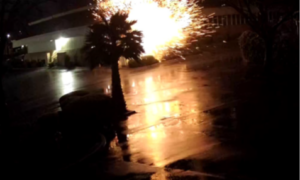Farmers in California’s Central Valley are confident that there will be enough water for this summer’s crops, thanks to two years of robust rainfall and a plentiful Sierra snowpack.
It’s welcome news for Californians working in agriculture, especially after the state has survived several years of on-and-off drought. For the Sierra snowpack, which helps supply water to the valley through sources such as the Kings River and Pine Flat Dam, the 2024 rainy season brought a “surprisingly average” year, as one University of Utah expert put it.
More than 250 crops are grown in the 400-mile stretch of valley floor in California, including 40 percent of the nation’s fruits and nuts, according to the California Water Science Center.
Water is the key component of this agricultural success. In 2024, the water supply began to recover from drought conditions after two years of heavy rainfall and flooding, but it has remained unclear if it would be enough to address community and agricultural water demands.
The word “drought” is a term that most experts would prefer Californians quit using because it’s “very region-specific,” according to Laura Ramos, director of the California Water Institute.
Funded by Fresno State University, the institute looks at water supply challenges in the valley and uses research to identify potential solutions.
“Being in a drought [and] being out of a drought is a hard definition,” she said, noting that in some regions of California, the mountains might be full of snow but the local wells may be dry. “To a person whose well went dry ... they don’t care!”
The issue is not whether California will get enough “wet” years or “regular” water cycles to keep up with the demand of communities and farmers. Ms. Ramos said sustainable water management comes down to developing infrastructure.
She pointed to the atmospheric rivers that brought record rainfall and flooding in California in 2023. “Last year, we were able to pump more water out of the delta, but we had nowhere to put it,” she said.
The Sacramento-San Joaquin Delta supplies water to two-thirds of California’s population and millions of acres of farmland, according to the California Department of Water Resources.
“Think of those [canals] as freeways—the freeways were completely full,” she said.
In the valley, California is considered a conjunctive use state, meaning the water supply comes from surface water and groundwater. According to a study by the Water Institute, historic overreliance on groundwater has diminished the quality and quantity of supply.
The 2014 Sustainable Groundwater Management Act (SGMA) has played a big part in the state’s approach to handling shortages. “We know that with SGMA, some of our land is going to be fallow,” Ms. Ramos stated.
The statewide framework encourages farmers to take acreage out of production to use as recharge basins. The basins are filled with surface water that slowly “recharges” the soil by flowing into the groundwater table. Ms. Ramos described the science as “making the water levels go up by sending water down.”
Groundwater basins provide around 40 percent of water for statewide farms and communities, according to a recent study from the Public Policy Institute of California. Before the passage of the Sustainable Groundwater Management Act in 2014, groundwater use was mostly unregulated.
Now, the management agency maintains and regulates basins throughout the valley, particularly in the southern Central Valley, where the basins are often critically over-drafted by 2 million acre-feet, according to the institute.
Despite the state’s efforts, water storage has remained an elusive problem.
In 2024, without enough infrastructure to capture water during heavy rain cycles, Ms. Ramos said that the best option for preparing for years of drought was to “take advantage of the wet years.”
Drought preparation and water transportation is also a common theme echoed among valley farmers, including Mike Strambi.
Mr. Strambi is a third-generation farmer and small business owner in the Central Valley. “We’re not running out of water,” he told The Epoch Times.
The problem, he said, came down to the groundwater sustainability agencies, which measure the “evapotranspiration rate” of agricultural ground. Evapotranspiration refers to the rate at which water vapor is returned to the atmosphere. In other words, if water evaporates out of a farmer’s field, the water district can bill them for it, Mr. Strambi said.
The “long-term solution” to managing water in California would be to preserve it, he said. He also called for limits on deep well drilling. He stated that drilling too much and too deep over the years had collapsed many underground aquifers in the state and eliminated the greater potential for long-term water sources.
Mr. Strambi criticized “big dollar companies” that have water rights and can resell it to big cities such as Los Angeles. He said there should “be no profiting in water—period.” He advocated starting with a “blank chalkboard” in the valley and focusing on commonsense water storage procedures.
“Now that the state is involved ... they’re not going to fix it with their satellites,” he said, referring to satellite surveillance that purports to track groundwater levels.
With two wet rain cycles in California and a hot summer ahead, will farmers have enough water to keep their crops flourishing until the end of the season? “We’re going to be OK,” Mr. Strambi said.
He noted that Pine Flat Lake, about 30 miles outside Fresno, was over 90 percent capacity this year. “That’ll carry these farmers through the summer,” he said.














